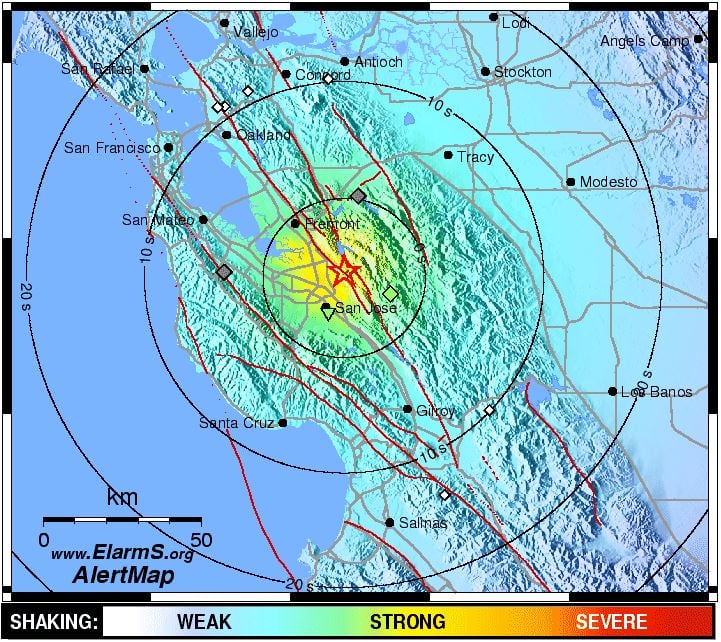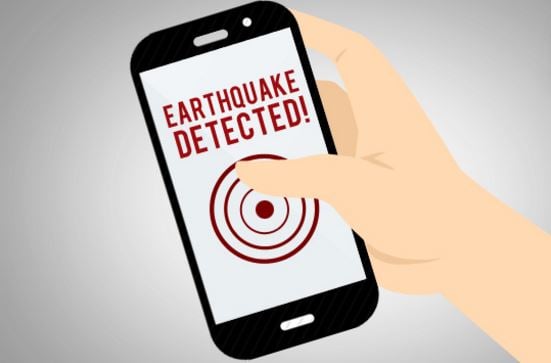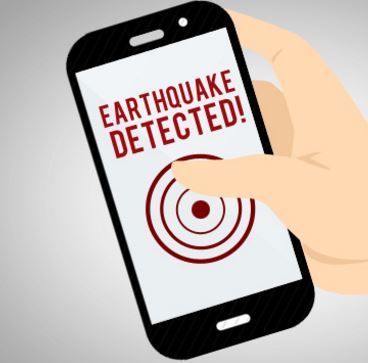California is ripe for the Big One, the mega earthquake that seismologists say hits the state periodically, but it is not ready and urgently needs an early warning system, say US lawmakers. The technology is there – the California Institute of Technology (Caltech) has a prototype, which with some investment could be used across the state.
Caltech says its early-warning system, called CISN ShakeAlert, would give California that vital time needed to get themselves somewhere safe before the quake hits them.
The system could easily be extended to cover the whole of the West Coast if the financing were there.
 A CISN EEW test system caught the 5.4 magnitude Alum Rock earthquake in 2007. The image shows the distribution of ground shaking intensity predicted using the first few seconds of data recorded by seismometers close to the epicenter in San Jose. The map was created using the data a few second before the shaking had reached San Francisco. (Image: cisn.org/eew)
A CISN EEW test system caught the 5.4 magnitude Alum Rock earthquake in 2007. The image shows the distribution of ground shaking intensity predicted using the first few seconds of data recorded by seismometers close to the epicenter in San Jose. The map was created using the data a few second before the shaking had reached San Francisco. (Image: cisn.org/eew)
A few million dollars to save many lives
Many scientists, politicians and members of the public are amazed that the US Government is unable to invest a few million dollars each year on an early-warning system that could save many thousands of lives, and potentially hundreds of billions of dollars in damage if the big one struck and the people were unprepared.
US Congress lawmakers said the federal investment would amount to just $16m (£10.7m) each year.
California is ready for the ‘Big One’, say seismologists, who describe the state’s seismic status as ‘Ten Months Pregnant’.
The ‘Big One’ is a hypothetical earthquake of magnitude 8 or more that is expected to occur along the San Andreas Fault (SAF) – a continental transform fault that extends about 1,300 km through California. SAF forms the tectonic boundary between the North American Plate and Pacific Plate.
High chance of the Big One striking
A recent study, carried out in partnership with the US Geological Survey, estimated that there is a 7% probability of a Big One in California within the next three decades.
In another study, performed in 2008, seismologists informed that a 7.8 earthquake occurring along the southern San Andreas Fault could cause 1,800 deaths and $213 billion in damage to property, buildings and infrastructure.
 Schoolchildren from Taft Middle School in San Diego drop, cover and hold on as part of the Great California Shake Out drill. With an early warning system, they could all be in position before the quake struck. (Image: presidiosentinel.com)
Schoolchildren from Taft Middle School in San Diego drop, cover and hold on as part of the Great California Shake Out drill. With an early warning system, they could all be in position before the quake struck. (Image: presidiosentinel.com)
Thomas Heaton, Professor of Geophysics and Professor of Civil Engineering, Director of the Earthquake Engineering Research Laboratory at Caltech, told Sky News:
“We’re trying to make it so that it is a functioning system but at this point the budget to actually turn it into a system that we would unleash on all Californians has not been approved so it is up to the politicians.”
One day everybody will have a sophisticated early warning system app on their smartphones, Prof. Heaton believes.
An early-warning-system could save deaths and prevent damage by giving the state time to slow down its road vehicles and trains, hospitals would be able to stop sensitive operations, schoolchildren would be able to get to their assembly points or emergency zones, gas stoves could be switched off, and millions of people at home or work would be able to get out of harm’s way.
 The 1906 San Francisco earthquake struck with a moment magnitude of 7.8 and a maximum Mercalli intensity of XI (Extreme). Fires broke out all over the city that lasted for several days. About 3,000 people died and more than 80% of the city was destroyed. The incident is remembered as one of the worst disasters in the history of the US. (Image: parks.ca.gov)
The 1906 San Francisco earthquake struck with a moment magnitude of 7.8 and a maximum Mercalli intensity of XI (Extreme). Fires broke out all over the city that lasted for several days. About 3,000 people died and more than 80% of the city was destroyed. The incident is remembered as one of the worst disasters in the history of the US. (Image: parks.ca.gov)
Californian’s would regret being unprepared
Prof. Heaton, who warns about being unprepared if the Big One strikes one day, said:
“Someday in our future we may have a very serious earthquake out there and I’m sure when that happens all of us will lament the fact that we hadn’t done more to be ready for it.”
In an interview with Sky News, U.S. Representative for California’s 28th congressional district, Adam Schiff, said:
“We’ll all be kicking ourselves if we’re pennywise but pound-foolish. Frankly it is mystifying to me to come from a technology centre like California with Silicon Valley and where the US Geological Survey and Caltech have developed a lot of this technology, and we don’t have it in place when it is already working in Mexico and Japan and other countries are far ahead of where we ought to be.”
An earthquake measuring 6.7 on the Richter scale struck the Los Angeles area in 1994. Five thousand people were injured, 57 died, and about $40 billion’s worth of damage to possessions, buildings, property and infrastructure was reported.
 The University of California demonstrated a smartphone app designed to give early warning of earthquakes at the World Science Forum in Rio de Janeiro. It is capable of providing an alert between a few seconds and one minute before a tremor hits. (Image: rappler.com/science-nature)
The University of California demonstrated a smartphone app designed to give early warning of earthquakes at the World Science Forum in Rio de Janeiro. It is capable of providing an alert between a few seconds and one minute before a tremor hits. (Image: rappler.com/science-nature)
Caltech’s Earthquake Early Warning
An international team of scientists and engineers from Caltech, the University of Southern California, UC Berkeley, USGS Pasadena, and the Swiss Federal Institute of Technology, are carrying our research and development on EEW (earthquake early warning).
Their collaboration began in 2007, and includes the development and implementation of CISN ShakeAlert – a recently-deployed EEW system made specifically for the State of California.
ShakeAlert utilizes information from the California Integrated Seismic Network (CISN, Caltech/UC Berkeley/USGS), including data streams from stations across the whole state.
The project was first funded by the US Geological Survey, which is responsible for all earthquake alerts across the whole of the US. In 2012, the Gordon and Betty More Foundation carried on funding the project, with 3-years’ worth of money.
Caltech writes in its FAQ web page ‘What is Earthquake Early Warning?’:
“When an earthquake occurs seismic waves radiate from the epicenter like waves on a pond. It is these waves we feel as earthquake shaking and cause damage to structures. The technology exists to detect moderate to large earthquakes so quickly that a warning can be sent to locations outside the area where the earthquake begins before these destructive waves arrive.”
The early warning system would give people in California from a couple of minutes to a few seconds’ warning of an impending quake, depending on how far from the epicentre they were. The system would definitely save many lives.
Video – How the Japanese early warning system works

